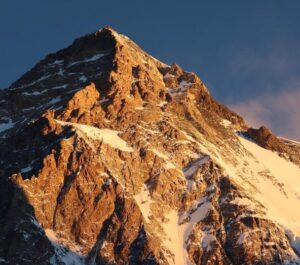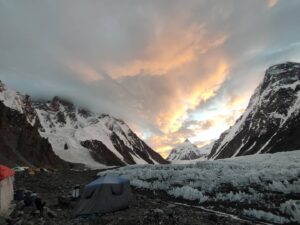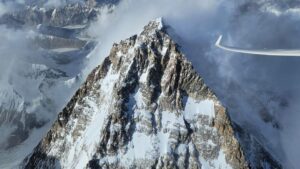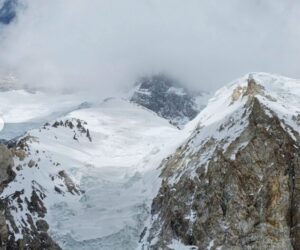Luo Jing Update, October 25
A day after Luo Jing of China recently claimed to have completed all 14 8000’ers by summiting Shishapangma, fellow climbers stepped forward to bitterly deny her claim. No one, they said, had reached Shishapangma’s main summit that day. The highest ones stopped on Shishapangma Central, at 8,008m, according to two Chileans and a Spanish climber present. The two Chileans explained that a huge expedition they described as the “Great Chinese Wall” dominated the mountain and imposed their strategy on the other teams. These Chinese climbers decided to go for Shishapangma Central instead of traversing the Basque route to the main summit.
The real surprise came when Luo Jing herself admitted and even proved that she had not reached Shishapangma’s main summit. The revelation appeared in an October 3 post on the Chinese site Jianshu.com. A member of the Far Eastern climbing community informed ExplorersWeb of this in a comment at the end of the original version of this story.
“I know this post will disappoint many people, but I have decided to send it anyway,” Luo Jing wrote. The Chinese climber explained that she felt unsure about the highest point achieved. After speaking to other climbers in Base Camp, she sent the summit video on November 3 to Eberhard Jurglaski of 8000ers.com for a creditable opinion.
Jurglaski’s answer confirmed her fears: “I am so sorry, but after I saw the “summit” pictures, I can confirm that you were only on Shishapangma Central, not the main peak,” he wrote. “You need to do it again somehow.” Luo Jing mentioned that \the expedition leader was hesitant to accept the facts, so Luo clarified that she is speaking only on her own behalf and not representing her climbing mates’ opinion.
So ends, for now, the story of the latest female 14×8000 summiteer. But a decade ago, controversy also surrounded the race to become the first woman to complete that daunting list.
More or less willingly, a handful of women became embroiled in what amounted to an undeclared war. The communications revolution that was exploding at the time magnified their every move and achievement, but also every failure and suspicion.

Edurne Pasaban in Annapurna BC, 2010. The peak became her 13th 8000’er. Photo: Ferran Latorre
In May, 2010, Basque climber Edurne Pasaban stood on the top of Shishapangma’s main summit with a TV crew. The 36-year-old had just won a race that she had repeatedly denied running – but a race that, in the end, she had hurried to finish. Before anyone else, whenever possible.
Pasaban climbed with all the weaponry of a modern expedition: highly experienced support climbers, TV coverage and big sponsors. She used supplementary O2 on Everest and during an agonizing descent of K2. On the other hand, she was always clear about her strategy and her climbs were fully documented.
Pasaban’s project was, however, dwarfed by the resources marshalled by the hardest-core contender of the quest: South Korean Oh Eun-sun.

Korean Oh Eun-sun, ready to win the 14×8000’er race.
The finalists
By 2008, Oh had laid waste to five 8000’ers, and her sponsors placed their bets on a non-stop run for the remaining nine. This included helicopter rides from BC to BC — where teams of Sherpas were already fixing the routes — wide use of bottled O2 and personal high-altitude Sherpas. The Korean was quiet about her methods, but crystal-clear on her intentions: She was there to win the game. She ticked off four 8000’ers that year and went for the same number in 2009. Fellow South Korean Go Mi-sun, also linking summits at an amazing speed, abruptly ended her career the worst possible way: She perished while descending Nanga Parbat.
Also tackling the 14×8000’er challenge were Italian Nives Meroi and husband Romano Benet. The couple climbed under certain self-imposed conditions: always together, never with supplementary O2. Meanwhile, Pasaban had summited Broad Peak in 2008 and decided that she would try to complete the list as well.
Shadows over Kangchenjunga
The three women shared Kangchenjunga Base Camp in the spring of 2009. Meroi eventually aborted her summit attempt when her husband fell seriously ill. Pasaban and Oh both reached the top, on different days. Their achievements caught the attention of the worldwide climbing community. The end game was approaching, and the grand finale was set between the two of them.

Romano Benet and Nives Meroi, always climbing together.
By now, sat phones and computers were common in BC. At home, press teams supplied media worldwide with pictures, human-touch anecdotes, dates, numbers and background for those unfamiliar with high altitude climbing. Interest grew, but so did suspicions.
While the Spanish climber had always shown ample proof of her success, secretive Miss Oh refused to give a satisfactory answer when asked about disturbing testimonies from other climbers about her 2009 Kangchenjunga ascent. Concerns included: no witnesses but her personal Sherpa, reports of Oh being too weak to proceed, a dubious summit pic with no reference points and which she eventually admitted was a post-summit pic, a flag supposedly left on the summit that suspiciously peeks out of her jacket in a later photo, contradictions, refusals for interviews, etc.
By the time Oh Eun-sun proudly stood on top of Annapurna I in April, 2010 – this time with a TV crew broadcasting live from the summit via satellite – and proclaimed herself the first female to complete all 14×8000’ers, the shadows on her resumé were too dark to ignore.

Edurne Pasaban, left, atop Jangchenjunga on a perfect morning.
After thorough research and a series of investigative pieces, ExplorersWeb declared her Kangchenjunga summit invalid. Himalayan Database’s Elizabeth Hawley likewise assessed Miss Oh’s claim as “disputed” and suggested that she return to Kangchenjunga. Even the Korean Alpine Federation declared her summit picture insufficient proof. The crown then went to the second in line: Edurne Pasaban and her perfect-morning summit shots on all 14×8000’ers. Game over.
The no-O2 premier league
Was it over, though? While Pasaban’s summits were not contested, some believed that the real challenge was to complete all 14 peaks without oxygen, as Reinhold Messner had done. Critics kept bringing up Gerlinde Kaltenbrunner. The Austrian was also climbing all the 8000’ers, without the media circus. She stayed away from big teams, high-altitude guides and, of course, bottled oxygen. She climbed — and often led the way — with close friends or her husband, Ralf Dujmovits. She was considered a top climber, regardless of gender, and was an asset to the strongest teams. Many of her regular mates would go on to join the list of 14×8000’er summiteers themselves: Dujmovits, Hirotaka Takeuchi, Vassili Pivtsof and Maxut Zhumayev.

Gerlinde Kaltenbrunner cheers on reaching the summit of K2 and becoming the first woman to climb all 14 of the world’s highest peaks without oxygen. Photo: Maxut Zhumayev/National Geographic
Kaltenbrunner completed the first female no-O2 14×8000’ers in 2011, on K2. It was her fourth attempt on that peak, and the culmination of a career which gained unanimous applause.
As for Meroi, she stayed with Benet through his sickness and long recovery. When both were back in shape, she resumed her quest and just completed her last peak, Annapurna, in 2017 at the age of 56. True to her original criteria, she did all 14 with Benet and without oxygen.
Life after the 14x8000ers
The first generation of 14×8000’er women then stepped down from headlines, more or less. Edurne Pasaban launched a failed attempt on Everest without oxygen in 2011. That seems to have been her last Himalayan outing. She focuses now on motivational speaking, running a small guiding company and motherhood. Last week, she announced a female empowerment climb on Nepal’s Mount Saipal, with an international team that will include four Nepalese women.
Oh Eun-Sun remains unavailable to ExplorersWeb. ExWeb collaborator Kyu Dam Lee notes that she is currently following a PhD track in Physical Education at Korea University. In 2011-13, she served as chair for the Korean Women’s Mountaineering Club.
Gerlinde Kaltenbrunner’s website describes charity climbs, lectures and TV documentaries. In the most recent production, Kaltenbrunner and Peter Habeler climbed 5,609m Mt. Damavand, the highest peak in Iran.
Finally, Nives Meroi told ExWeb that she and Benet did not manage to go to the Himalaya this year but have plans to return in 2019. “Meanwhile,” she said, “we are at home, working: Romano runs the shop and I am writing a new book and lecturing in Italy. And, of course, we climb near our home of Tarvisio.”






